|
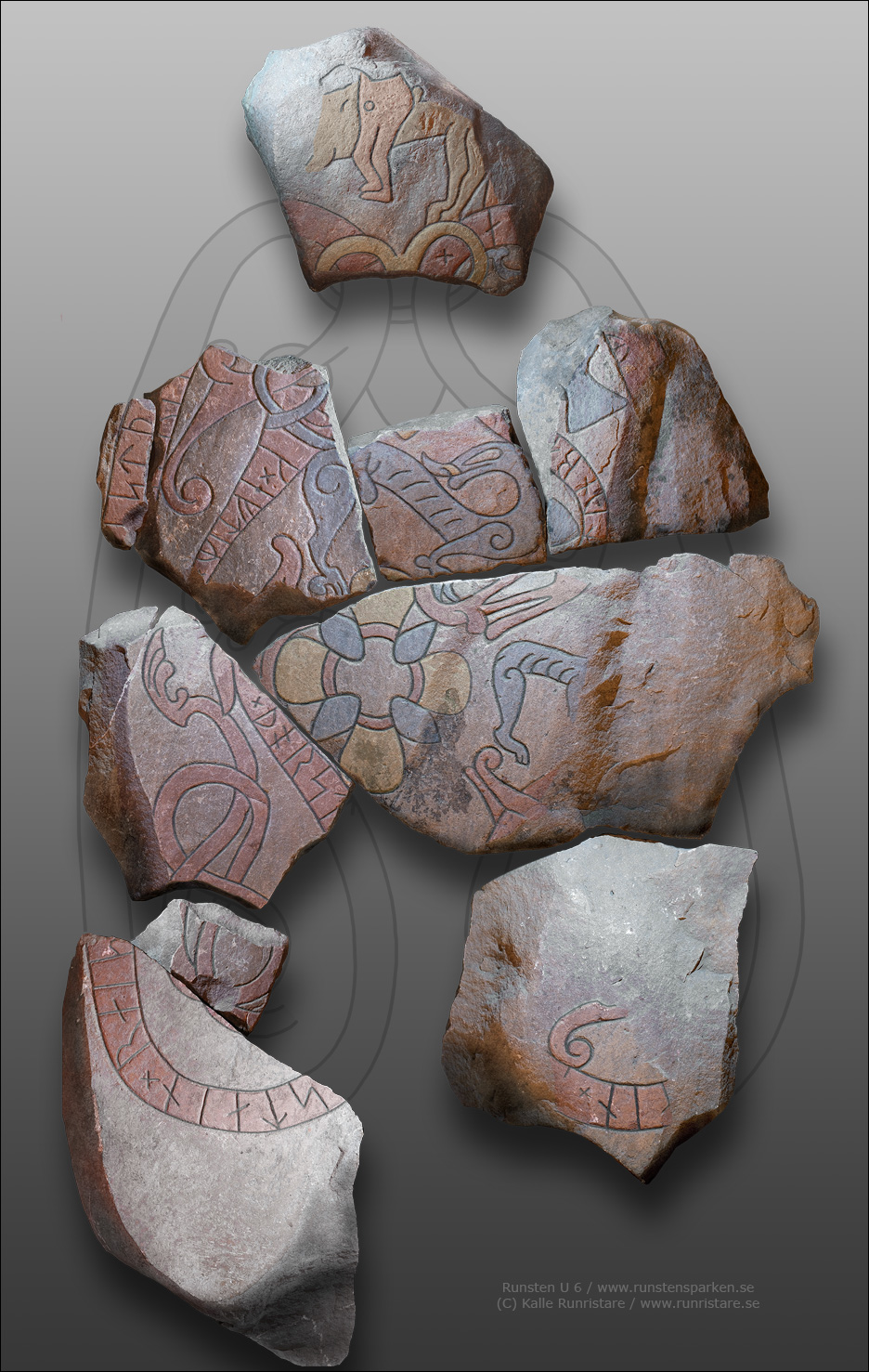
Ornamentation and motifs in detail:
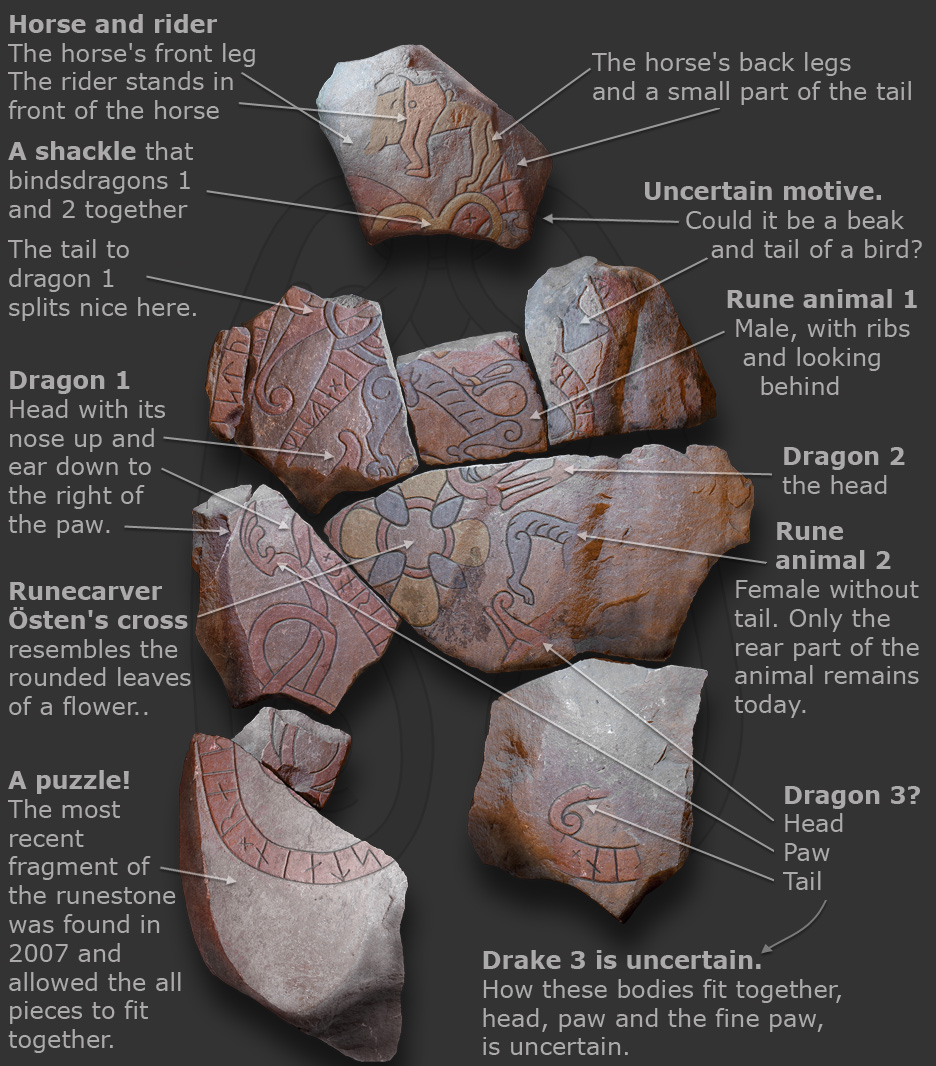
Runic inscription:
The fragmentary runic inscription goes over
the two dragons. It starts at the neck of dragon 1 on the
left between the beautiful paw and the cross.
Dragon 1
Torsten (and) …
-stone raised …
(sfter) Estrid .? …
and after
× þorst… … …stain × rais…
… -str-- …-… …uk × eftiR ×
Dragon 2 (continued)
Tunba…
Östen .?…”.
…tunba… × … × a… …R… …ain
× …
Below are the facts mixed
with my descriptive description of how I think the story
of the runestone came to be. Here you have to try to
separate fact and fiction on your own.
About the runecarver
The rune carver's name is Osten!
Although the runic inscription is
fragmentary, we can still determine that the runcarver is
Östen by his unique details in images and ornamentation such
as the floral cross and the small round animal with ribs.
When I try to follow Östen as a runecarver, I find him in
the area around Bornsjön in Salem (14 km southeast of
Birka) where some of his earlier runestones are found.
I find two of Östen's carvings that seem to
be even older, his first tentative attempts in Huddinge
church, Sö 299 and Botkyrka church Sö 283.
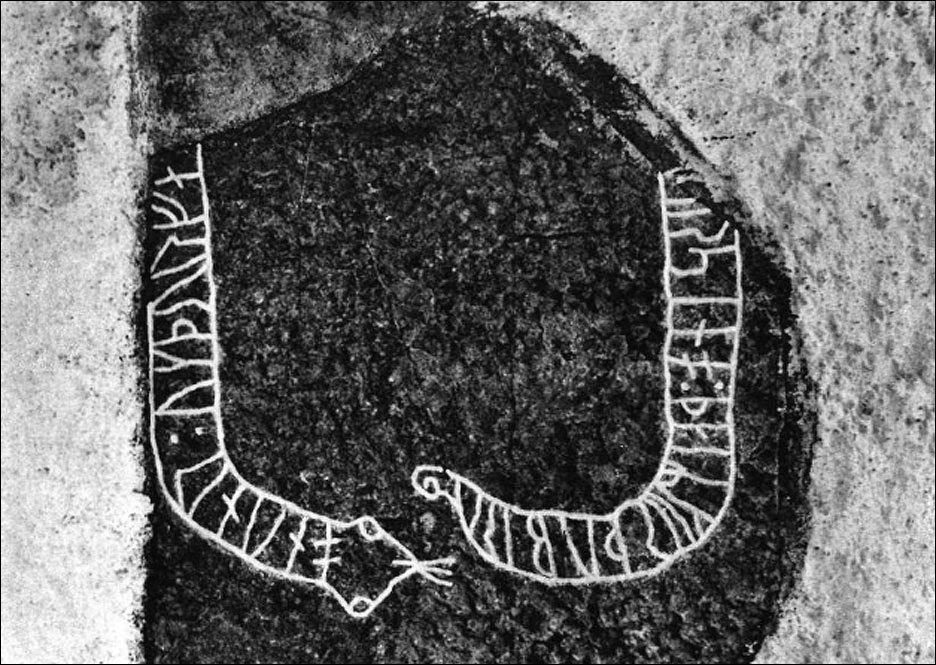
Huddinge church,
Sö 299,
page 276
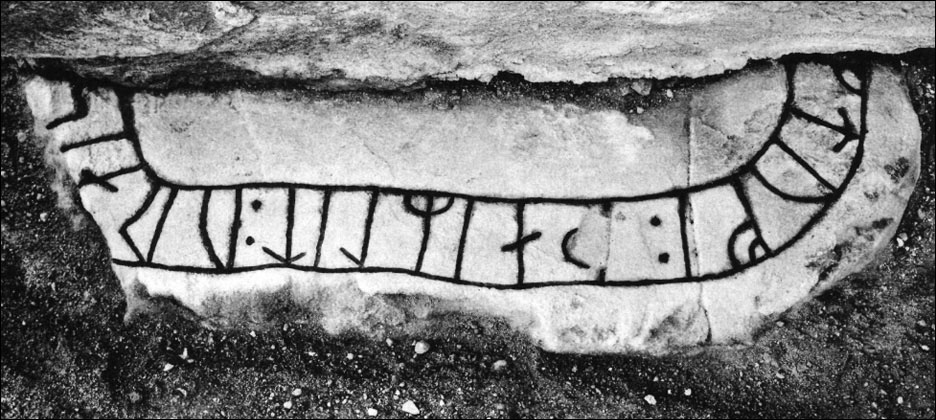
Botkyrka church
Sö 283,
page 249
Later in his career and when he has become a
little more confident in his work, he carves directly on
granite slabs. That work is much heavier and more difficult
than carving on a stone that is lying down and which you
raise afterwards.
(It may seem unlikely that the same
runecarver made these runestones but there is a common
denominator and "common thread" to follow).
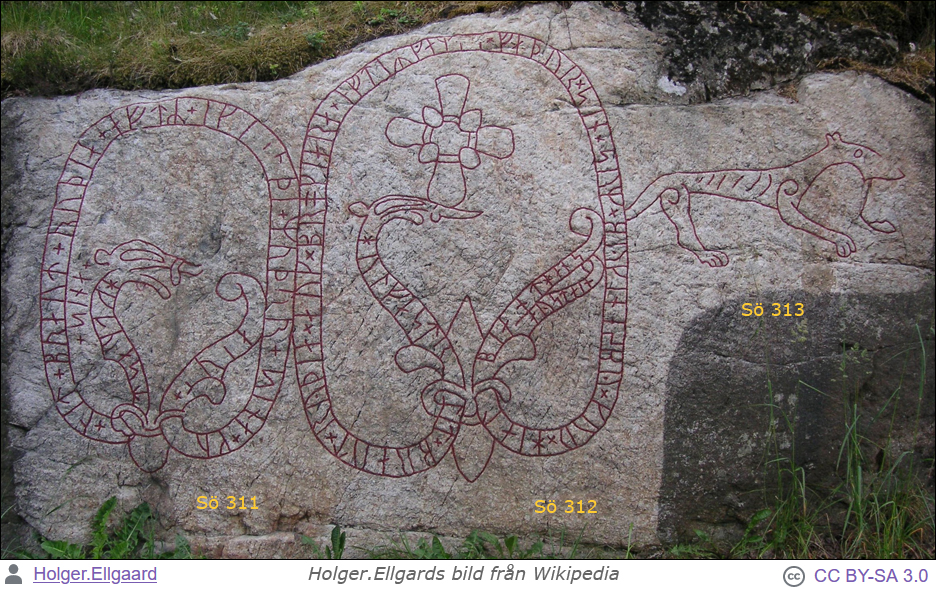
By the old road in Södertälje, up by today's Torekällberg,
he carves Sö 312 with the rune animal to the right of Sö 313. Östen has not carved the left one, Sö 311.
After this he carves the slabs in Vitsand, Sö
344b (or: Sö ATA322-1467-2011) and Kiholm, Sö 344a.
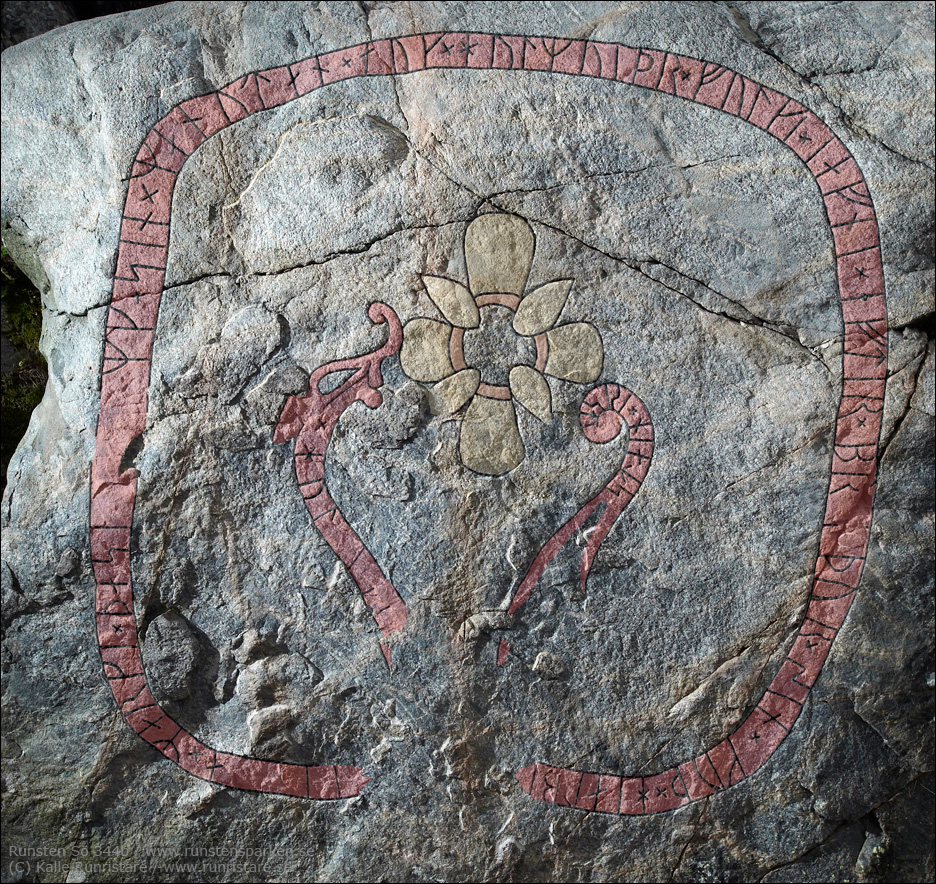
Vitsand, Sö 344b (or: Sö
ATA322-1467-2011)
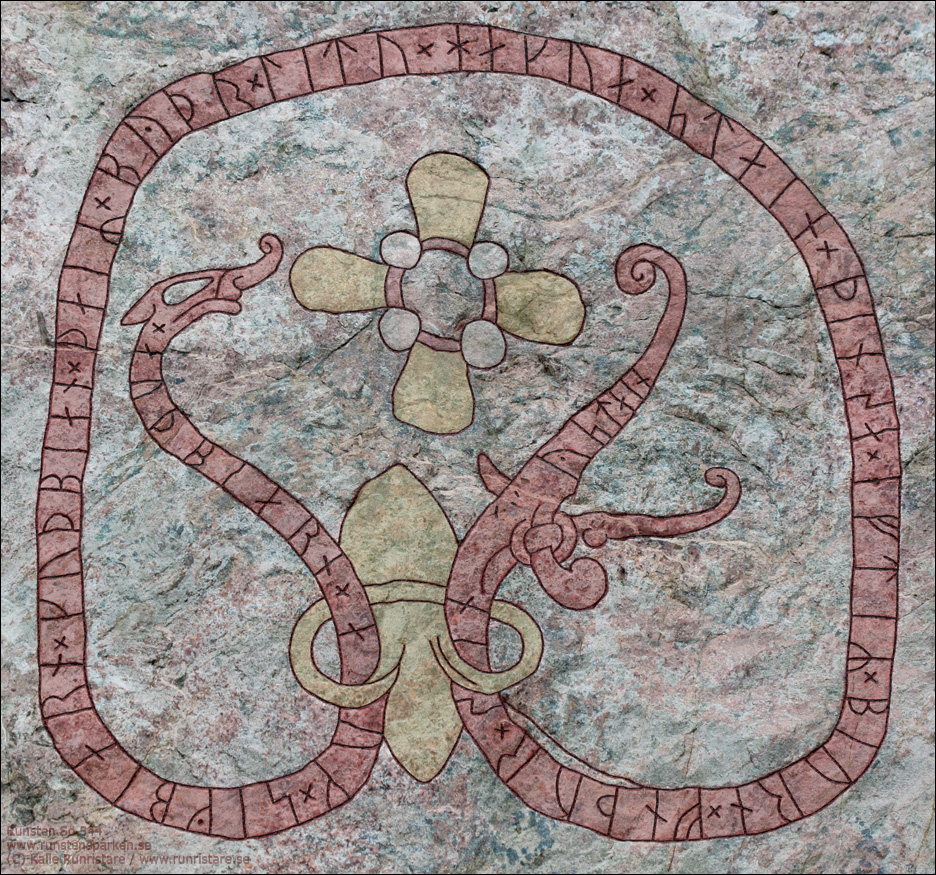
Kiholm, Sö 344a
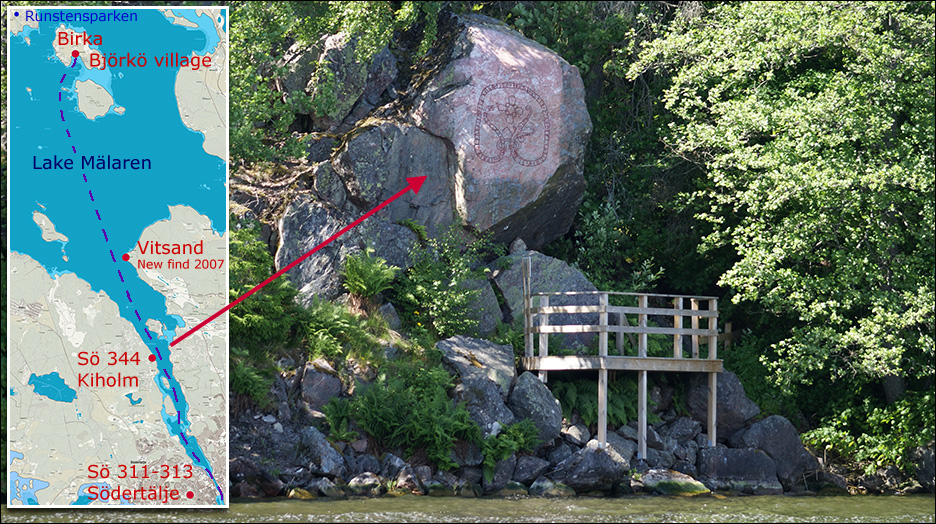
When the water level in the 11th century was 5 meters
higher than today, the two carvings were just above the
water line.
Östen in Björkö village
Björkö village is next to the town of
Birka. (Birka as a city disappears around the year 980 and
Östen carves this U 6 in Björkö village around the year
1065).
The day Östen came to Björkö village to take part in his
next project, he must have been very happy for the
assignment. There on the ground lay a large stone of red
sandstone that the client wanted Östen to carve a beautiful
runestone from. Östen was also allowed to design the artwork
freely according to his own inspiration.
Sandstone
It is much easier to carve in sandstone than in granite.
Sandstone also does not break as easily when carving small
details or making tight cuts.
Instead, the disadvantage of sandstone is that it does not
withstand abrasion and that it easily breaks into pieces
when struck and bumped.
Östens ornamentation
Östen has always had a taste for pictures and animal motifs
and he has long tried to imitate some of the motifs he saw
in his younger days. The round animal with ribs reappears on
several of his carvings, but it is only here on U 6 that it
finally gets really good, the same goes for the beautiful
paw.
Here on the lightly carved runestone in
Björkö village, he unleashes all his creativity and fills
the surface with beautiful ornamentation and images and of
course the client's runic inscription.
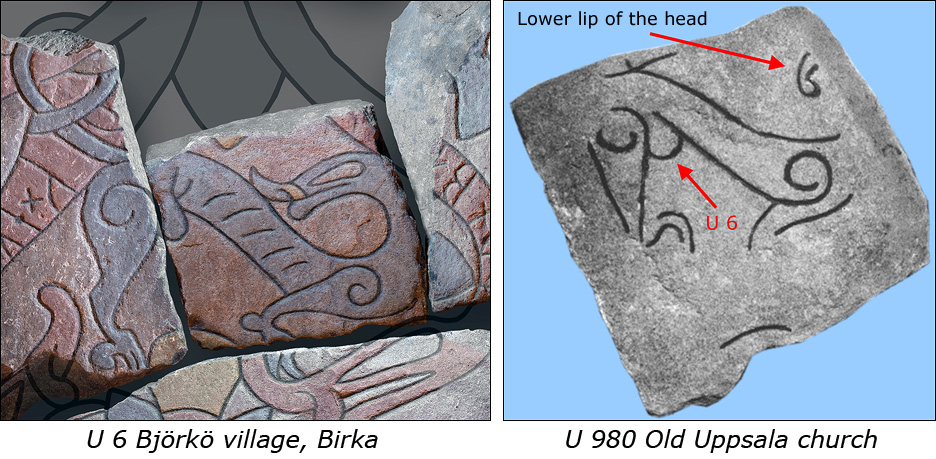
The runestone is raised
The finished runestone was probably erected on a hill in the
village's harbor with the image surface facing the water. It
stood there for a long time in all its splendor and both
welcomed and impressed the village's guests and visitors.
The runestone falls
After a long time, perhaps 100 to 200 years, the ground
gives way to the weight of the runestone, perhaps after a
long period of rain in autumn. The runestone falls forward
with the carved surface towards the ground.
Perhaps the care of the rune stone had been
neglected so that moss and lichen began to take over the
surface of the stone, perhaps the color faded and flaked.
Maybe the memory of the people in the runic inscription has
started to fade?
Raising the heavy runestone again was going
to be hard work that was left until later... then it was
forgotten, more and more, until no one remembered that there
was a runestone lying there on the ground with its back
facing up.
The runestone is accidentally destroyed.
A few hundred years later, perhaps in the 15th-17th
centuries, the memory of the runestone had been completely
forgotten. One day when they were looking for suitable
stones for the foundations of new houses in the village, the
choice fell on the large red stone that had long lain above
the old harbour.
The stone was too large to be used as it was
and needed to be broken into pieces. Wood was piled up on
the stone and fires were lit. After burning for a while and
when the stone was very hot, cold water was thrown on the
stone, which was immediately shocked and burst into pieces.
When the cracked pieces were turned over and
it was seen that it was a runestone that had been destroyed,
the pieces still had to become building material as it was
intended from the beginning.
Pieces are found again
During the 19th century, several pieces of the old runestone
began to appear in Björkö village during the rebuilding and
renovation of old houses.
When "Uppland's runic inscriptions" were
written in the 1940s, it was believed that the pieces
belonged to different runestones, so they were named U 6, U
7 and U 8.
The latest find from the year 2012 makes it
clear that all the pieces may belong to the same rune stone
and a ten-piece puzzle begins to be put together.
Three runestones become one
The attempt to put the pieces together was successful and
the result was that the ten fragments became a rune stone
that was now named U 6.
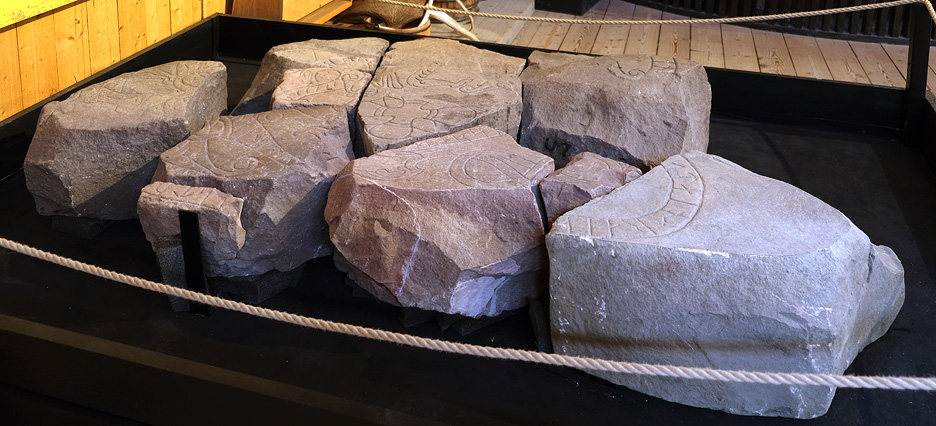
The ten pieces of U 6 can be seen in the
museum at Birka.
The fragments of U 6 known today (about 70%) are laid out
like a big puzzle and can be seen in the museum at Birka. A
full-scale image with colors can be found here in
Runstensparken and the best image is perhaps the one you see
here at the top of the web page!
30% of the carving is still missing...
Several parts of the runestone remain in or around the
houses in Björkö village and are waiting to be found. But
the smaller, but oh so important little pieces and shards
after the runestone was split are left in the place where
the runestone was first raised and later fell.
But we don't know the exact location, we
think it's on a hill by the village harbor. The location
should be clearly visible towards the bay for arriving boats
and should be at least five meters above the lake's water
surface today.
The rune stone should also have been near the
road or path that existed between the harbor and the village
so that whoever wished could easily walk up to the rune
stone and study it more closely.
Reflection
I wonder how the boat crews experienced the carvings along
the shipping trail, were they just decorative, beautiful and
inviting or did they also give some kind of respect to the
areas they were heading towards?
I also wonder if Björkö village was the last runic carving
or if there are more further north in the fairway up towards
the new Sigtuna or old Uppsala?
The carving at Vitsand was found by pure luck as recently as
2007, so there may be more...
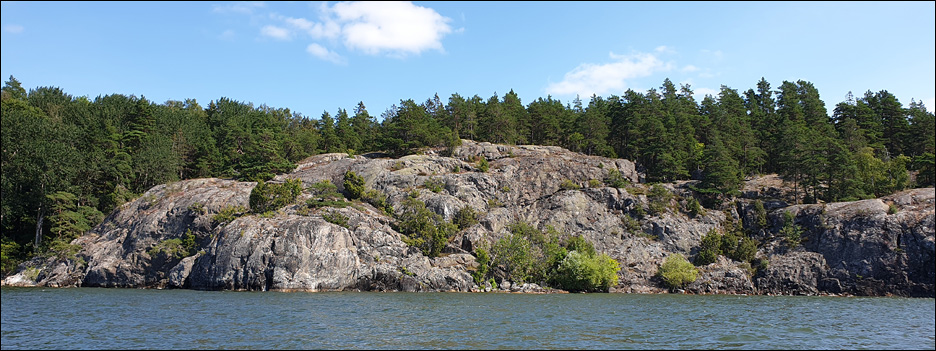
If you want and can search for these
"possible" runecarvings, you should search in the fairway
north from Birka towards Sigtuna and Old Uppsala on clearly
visible rock slab at least 4.5 meters above Lake Mälaren.
Visit the runestone.
It can be seen inside the museum at Birka
Links
1943
Upplands runinskrifter >
U6, U7 and U8 at page 9-10 (Swedish)
1992
Fornvännen >
Page 230 (Swedish)
Two puzzle pieces are found (av U 6)
2012
Fornvännen > (Swedish)
About the latest find and the puzzle
2013-02-15
Birkaprojektet > A rune stone emerges. (Swedish)
2013-02-18
K-blogg > The puzzle continues (Swedish)
Runor > - Riksantikvarieämbetet
Map and runic inscription.
Google map >
Find the runestone
Contact:
kalle@runristare.se
If you want to be of help or have a question.
All runestones in the
Runestone Park
We start from the north and go clockwise
U 11 - Adelsö, Hovgården
The King's Runestone in Hovgården, Adelsö
U 3 - Hovgården, Alsnöhus
Found during an excavation in 1916
U 1 - Adelsö church
Former threshold stone to the sacristy. Now built
into the wall in the sacristy.
U 2 - Adelsö
church
Destroyed by fire around 1660. Former threshold stone
to the church.
U 10 - Dalby Adelsö
Found in 1920 at Stora Dalby, northern Adelsö. Now
built into the wall of the sacristy, Adelsö church.
U 6 - Björkö village on Birka
Several fragments as a puzzle. Now in the museum at
Birka.
U 5b - Birka
2015
(New find 2015)
2024.03.10 Not yet documented or published.
Sö 141b
- Aspa bridge (Sö Fv1948;289)
New find in 1937 with the name Svitjod (Sweden).
Sö 179
- The Gripsholm runestone
Mariefred, the most famous of the Ingvars runestones.
U 887 - Skillsta runestone
One of the world's most beautiful runestones.
Vs 29 - Sala parish church
The runecarver Livsten's masterpiece.
U 1125
- The old man in Krogsta
1500 year old rune stone carved with the older runes,
the Old Norse runes.
|





